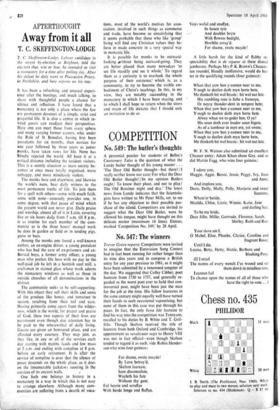Chess no. 435
PHILIDOR
Black _White
11 nwn
10 men
B. Smi h (The Problemist, Nov. 1968). White to play and mate in two moves; solution next week. Solution to no. 434 (Shinkmant: Q - R 8! no
threat. 1 ... Kt – Kt 4; 2 Kt – K 5. 1 ... Kt else; 2 R – Kt 7. 1 . . K X Kt; 2 B – Q 1. 1 . . . K – B 4; 2 Q – B 8. Well-hidden key and fine variations; a gem.
The chess aristocracy
A very interesting analysis of the holders of the grandmaster and international master titles has just been published in the Swiss periodical International Chess Express. These titles are awarded on the basis of performance in tournaments containing certain proportions of players who are already title holders —and to retain an 'active' title (i.e. one which is valid for tournament ratings) one must renew it every five years by a performance of the required standard. As systems go, it is not too bad but does lend itself to a fair amount of rigging of tourna- ments by inviting substandard cms and ims in order to allow local players to acquire the title.
Altogether, at the end of 1968 there were 65 active and 21 passive cots, 1 I 1 active and 120 pas- sive rms. The USSR heads the list with 25 active, 6 passive cm and 14 active, 15 passive ims; Yugo- slavia is runner-up with 8/3 GMs and 17/7 am; the leading countries in the western world are USA 5/5 cms and 1/9 ims. W. Germany 3/1 cms and 5/8 am and Argentina 2/4 cms with 3/11 ims. England has the modest score of no GMS and 2/4 ims; there is no doubt that Penrose is well up to GM standard and Keene a good IM but insufficient tournament opportunities have prevented their yet gaining these titles.
In view of their totals it may seem surprising to say so but to my mind the most interesting feature in the detailed table is the relative decline of the Russians. If we take their present leading players we see the following picture: the world champion Petrosian (aged thirty-nine) became a GM when twenty-three-, his challenger Spassky (aged thirty- two) was a cm at eighteen. Tal a cm at nineteen, Korchnoi and Bronstein at twenty-five. Geller at twenty-seven, and Polugayevsky at twenty-eight. There is, however, no Soviet grandmaster who is now under thirty and only two Soviet IMs—Savon aged twenty-eight and the woman world champion Nona Gaprindashvili, aged twenty-seven. A player
of world class would almost certainly reach cm by the middle twenties—in addition to those listed above Smyslov, Keres and Botvinnik were all cm in their early twenties; Fischer was a cm at the age of fifteen (the youngest ever), Larsen at twenty-one. Where, then, are the great Soviet masters of the future? Maybe about 1980 we shall have a non- Russian world champion again.











































 Previous page
Previous page